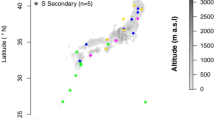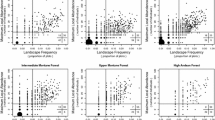Abstract
Competitive interactions between New Zealand's four Nothofagus or southern beech species were analysed using an extensive dataset describing the composition of natural forests, supplemented by environmental estimates describing both climate and landform. Using multiple regression models of progressively increasing complexity, the analysis first accounted for variation in tree abundance attributable to both environment and regional-scale distributional disjunctions of likely historic origin. Intra-generic competition, expressed as variation in tree abundance dependent on the presence or absence of each congener, was then assessed by adding (1) simple terms to assess the magnitude of gross changes in abundance, and (2) interaction terms to assess variation in abundance along the dominant temperature gradient given different competitive contexts. Results indicate the presence of substantial intra-generic interactions, with simple interaction terms giving marginal increases in explained deviance equal to that explained by initial regressions using environment alone. Addition of interaction terms brought about smaller improvements in model fit, but confirm that variation in abundance along the dominant annual temperature gradient is strongly influenced by the competitive context provided by the remaining congeners. Such results are consistent with current understanding of the niche concept, and underline the difficulty inherent in using current species limits to predict likely changes in species distributions consequent on global warming.
Similar content being viewed by others
References
Aarssen L.W. and Epp G.A. 1990. Neighbour manipulations in natural vegetation: a review. Journal of Vegetation Science 1: 13–30.
Austin M.P. and Meyers J.A. 1996. Current approaches to modelling the environmental niche of eucalypts: implications for management of forest biodiversity. Forest Ecology and Management 85: 95–106.
Austin M.P. and Smith T.M. 1989. A new model for the continuum concept. Vegetatio 83: 35–47.
Baylis G.T.S. 1980. Mycorrhizas and the spread of beech. New Zealand Journal of Ecology 3: 151–153.
Borcard D. and Legendre P. 1994. Environmental control and spatial structure in ecological communities: an example using oribatid mites (Acari, Oribatei). Environmental and Ecological Statistics 1: 37–61.
Burrows C.J. 1990. Processes of Vegetation Change. Unwin Hyman, Boston, Massachusetts.
Callaway R.M. 1995. Positive interactions among plants. Botanical Review 61: 306–349.
Davis M.B. 1989. Lags in vegetation response to greenhouse warming. Climatic Change 15: 75–82.
Hastie T. and Tibshirani R.J. 1990. Generalized Additive Models. Chapman & Hall, London.
Hutchinson G.E. 1957. Concluding remarks. Cold Spring Harbour Symposia on Quantitative Biology 22: 415–427.
Keddy P.A. 1989. Competition. Chapman & Hall, London.
Keddy P.A. 1992. Assembly and response rules: two goals for predictive community ecology. Journal of Vegetation Science 3: 157–164.
Landsberg J.J. 1986. Physiological Ecology of Forest Production. Academic Press, London.
Leathwick J.R. 1995. Climatic relationships of some New Zealand forest tree species. Journal of Vegetation Science 6: 237–248.
Leathwick J.R. 1998. Are New Zealand's Nothofagus species in equilibrium with their environment? Journal of Vegetation Science 9: 719–732.
Leathwick J.R. and Austin M.P. 2001. Competitive interactions between tree species in New Zealand's old-growth indigenous forests. Ecology 82: 2560–2573.
Leathwick J.R. and Mitchell N.D. 1992. Forest pattern, climate and vulcanism in central North Island, New Zealand. Journal of Vegetation Science 3: 603–616.
Leathwick J.R. and Stephens R.T.T. 1998. Climate surfaces for New Zealand. Landcare Research Contract Report LC9798/126.
Leathwick J.R. and Whitehead D. 2001. Soil and atmospheric water deficits, and the distributions of New Zealand's indigenous tree species. Functional Ecology 15: 233–242.
Leathwick J.R., Whitehead D. and McLeod M. 1996. Predicting changes in the composition of New Zealand's indigenous forests in response to global warming: a modelling approach. Environmental Software 11: 81–90.
McGlone M.S. 1985. Plant biogeography and the late Cenozoic history of New Zealand. New Zealand Journal of Botany 23: 723–749.
McGlone M.S., Mildenhall D.C. and Pole M.S. 1996. History and palaeoecology of New Zealand Nothofagus forests. In: Veblen T.T., Hill R.S. and Read J. (eds) The Ecology and Biogeography of Nothofagus Forests. Yale University Press, New Haven, Connecticut, pp. 83–130.
Ministry of Works 1974. Land Use Capability Survey Handbook: A New Zealand Handbook for the Classification of Land. Ministry of Works, Wellington, New Zealand.
Mueller-Dombois D. and Ellenberg H. 1974. Aims and Methods of Vegetation Ecology. John Wiley and Sons, New York.
Ogden J., Stewart G.H. and Allen R.B. 1996. Ecology of New Zealand Nothofagus forests. In: Veblen T.T., Hill R.S. and Read J. (eds) The Ecology and Biogeography of Nothofagus Forests. Yale University Press, New Haven, Connecticut, pp. 25–82.
Schoener T.W. 1983. Field experiments on interspecific competition. American Naturalist 122: 240–285.
Simberloff D. 1983. Competition theory, hypothesis test, and other community ecological buzzwords. American Naturalist 122: 626–635.
Stewart G.H. and Rose A.B. 1990. The significance of life history strategies in the developmental history of mixed beech (Nothofagus) forests, New Zealand. Vegetatio 87: 101–114.
Venables W.N. and Ripley B.D. 1994. Modern Applied Statistics with S-Plus. Springer-Verlag, New York.
Wardle J. 1984. The New Zealand Beeches: Ecology, Utilisation, and Management. New Zealand Forest Service, Wellington, New Zealand.
Wardle P. 1963. Evolution and distribution of the New Zealand flora, as affected by quaternary climates. New Zealand Journal of Botany 1: 3–17.
Wardle P. 1991. Vegetation of New Zealand. Cambridge University Press, Cambridge, UK.
Yee T.W. and Mitchell N.D. 1991. Generalized additive models in plant ecology. Journal of Vegetation Science 2: 587–602.
Author information
Authors and Affiliations
Rights and permissions
About this article
Cite this article
Leathwick, J. Intra-generic competition among Nothofagus in New Zealand's primary indigenous forests. Biodiversity and Conservation 11, 2177–2187 (2002). https://doi.org/10.1023/A:1021394628607
Issue Date:
DOI: https://doi.org/10.1023/A:1021394628607




